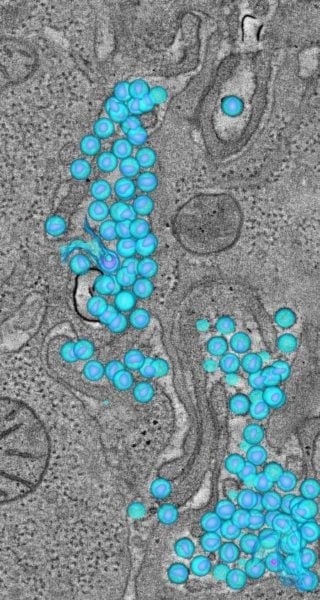A team of scientists at the Gladstone Institutes has identified a new way to make latent HIV reveal itself, which could help overcome one of the biggest obstacles to finding a cure for HIV infection. They discovered that increasing the random activity, or noise, associated with HIV gene expression–without increasing the average level of gene expression–can reactivate latent HIV. Their findings were published today in the journal Science.
When HIV infects an immune cell, it inserts its genetic material into the DNA of the infected cell. In most cases, the immune cell’s machinery makes copies of the viral genetic material, a process known as transcription. This eventually leads to the production–or expression–of all the components needed to make more viruses. The new viruses are released from the infected cell and spread the infection to other immune cells in the body.
In some cases, however, HIV expression goes into a holding pattern and the virus enters a latent state within the infected immune cell. This means that a small percentage of HIV hides in infected cells, beyond the reach of even the most potent drugs. As a result, we cannot completely eliminate HIV from the body, and people with HIV infection have to take antiretroviral drugs (ARVs) for the rest of their lives.
“Understanding how to reactivate latent HIV is one of the major challenges we must overcome in order to find a cure for HIV,” said Leor Weinberger, PhD, Associate Investigator in the Gladstone Institute of Virology and Immunology and senior author of the study. Roy Dar, PhD, the lead author of the study, added, “If we can make the virus show itself, we can then use ARVs to eliminate it. This so-called ‘shock and kill’ approach holds great promise, but to date it has unfortunately shown only limited success.”
One of the properties of latency that makes it so difficult to address is that it is random–or stochastic–in nature. Random fluctuations in transcription are unavoidable and a general aspect of life at the single-cell level and lead to “noise” around the average level of gene expression. HIV happens to have exceptionally noisy gene expression. Scientists have previously identified compounds that can reactivate HIV by activating transcription, but these compounds are not very effective, in part because of the noisiness of HIV transcription.
In this study, the team tested the counter-intuitive notion that compounds that increase noise in gene expression could work together with transcriptional activators to increase overall levels of HIV reactivation. The concept borrows from other fields of science such as chemistry, where theoretical arguments long ago argued that increased fluctuations can increase the efficiency of reactions.
First, they screened a library of 1,600 compounds using a specialized cell line that produces a green fluorescent protein (GFP) when gene expression is activated. The team identified 85 small molecules that increased noise without changing average GFP gene expression levels. They then combined these newly identified noise enhancers with known transcription activators in a cell line that serves as a model for HIV latency.
They found that while the noise enhancers could not cause reactivation on their own, 75 percent of them could synergize with activators and increase viral reactivation relative to activator alone. In fact, some noise enhancers doubled reactivation levels when combined with activators. Furthermore, they found a direct correlation between noise enhancement and the degree of reactivation synergy; the greater the noise, the greater the effect on reactivation. For the first time, these results show that expression noise and reactivation of latent HIV are directly related, and identify new candidates for the “shock and kill” approach to treating latent HIV infection.
Strategies to reverse HIV latency will likely require multiple rounds of treatment, and these new results suggest that noise-enhancing compounds may allow each round of treatment to be more effective at getting HIV to reveal itself. Additional screens for noise-enhancing activity may identify compounds that synergize with activators even better and are more efficient at reactivating the virus in order to eliminate it for good.
“The implications for using noise also extend far beyond HIV reactivation, since random cellular activity contributes to a wide range of processes, from antibiotic persistence to cancer metastasis”, said Dr. Weinberger. “Thus, this approach could represent a new tool for drug discovery across multiple fields.”


